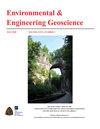The Effects of Particle Segregation on Debris Flow Fluidity Over a Rigid Bed
IF 1
4区 工程技术
Q4 ENGINEERING, ENVIRONMENTAL
引用次数: 3
Abstract
It is essential to consider the fluidity of a debris flow front when calculating its impact. Here we flume-tested mono-granular and bi-granular debris flows and compared the results to those of numerical simulations. We used sand particles with diameters of 0.29 and 0.14 cm at two mixing ratios of 1:1 and 3:7. Particle segregation was recorded with a high-speed video camera. We evaluated the fronts of debris flows at 0.5-second intervals. Then we numerically simulated one-dimensional debris flows under the same conditions and used the mean particle diameter when simulating mixed-diameter flows. For the mono-granular debris flows, the experimental and simulated results showed good agreement in terms of flow depth, front velocity, and flux. However, for the bi-granular debris flows, the simulated flow depth was less, and both the front velocity and flux were greater than those found experimentally. These differences may be attributable to the fact that the dominant shear stress was caused by the concentration of smaller sediment particles in the lower flow layers; such inverse gradations were detected in the debris flow bodies. Under these conditions, most shear stress is supported by smaller particles in the lower layers; the debris flow characteristics become similar to those of mono-granular flows, in contrast to the numerical simulation, which incorporated particle segregation with gradually decreasing mean diameter from the front to the flow body. Consequently, the calculated front velocities were underestimated; particle segregation at the front of the bi-granular debris flows did not affect fluidity either initially or over time.颗粒偏析对刚性床上泥石流流动性的影响
在计算泥石流锋面的冲击时,必须考虑其流动性。在这里,我们对单颗粒和双颗粒泥石流进行了水槽试验,并将结果与数值模拟结果进行了比较。我们使用直径为0.29和0.14 cm的砂粒,混合比例为1:1和3:7。用高速摄像机记录颗粒偏析。我们每隔0.5秒对泥石流前缘进行评估。在此基础上,对相同条件下的一维泥石流进行了数值模拟,并在模拟混合粒径时采用平均粒径。对于单颗粒泥石流,实验结果与模拟结果在流深、锋面速度和流量方面吻合较好。而对于双颗粒泥石流,模拟流深较小,锋面速度和通量均大于实验值。这些差异可能是由于主要剪切应力是由较低流层中较小泥沙颗粒的浓度引起的;在泥石流体中发现了这种逆级配。在这些条件下,大部分剪切应力由下层较小的颗粒支撑;与数值模拟中从前缘到流体平均直径逐渐减小的颗粒偏析相比,泥石流特征与单颗粒流相似。因此,计算出的前速度被低估了;双颗粒碎屑流前缘的颗粒偏析在最初或随着时间的推移对流动性没有影响。
本文章由计算机程序翻译,如有差异,请以英文原文为准。
求助全文
约1分钟内获得全文
求助全文
来源期刊

Environmental & Engineering Geoscience
地学-地球科学综合
CiteScore
2.10
自引率
0.00%
发文量
25
审稿时长
>12 weeks
期刊介绍:
The Environmental & Engineering Geoscience Journal publishes peer-reviewed manuscripts that address issues relating to the interaction of people with hydrologic and geologic systems. Theoretical and applied contributions are appropriate, and the primary criteria for acceptance are scientific and technical merit.
 求助内容:
求助内容: 应助结果提醒方式:
应助结果提醒方式:


